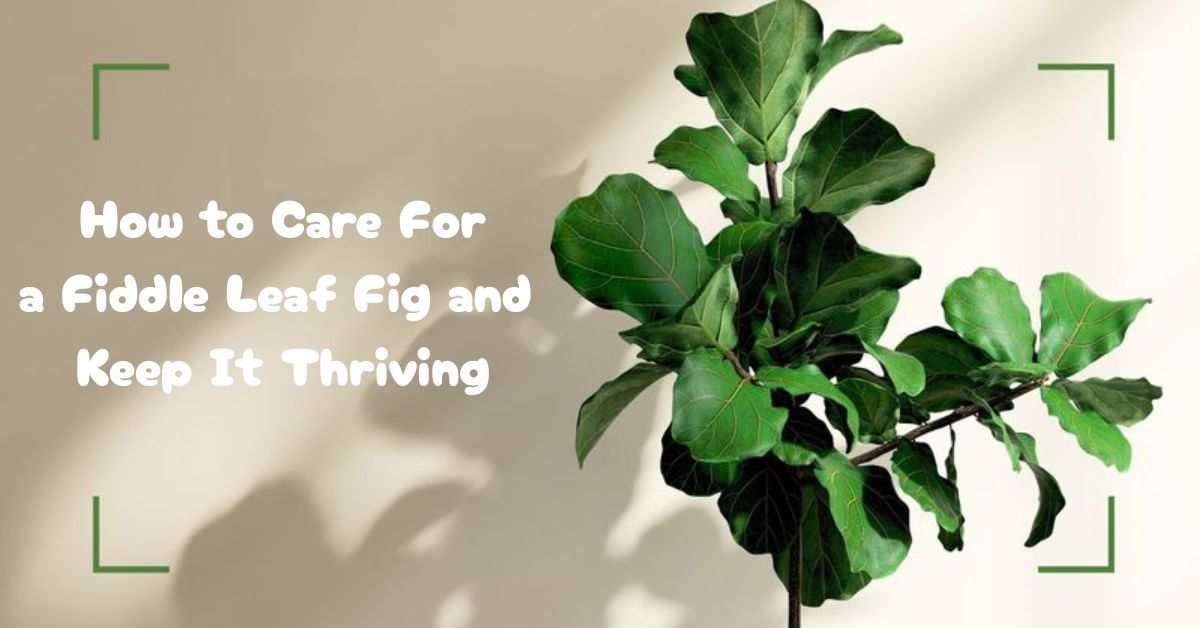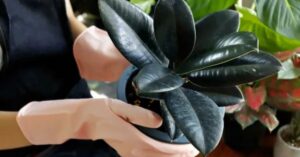Fiddle leaf figs have stolen hearts over Integral bolsters and living rooms around the world. These staggering plants brag expansive, violin-shaped clears out that right away change any space into a green desert garden. However numerous plant guardians observe defenselessly as their fiddle leaf fig drops takes off or creates brown spots.
Here’s the truth: these tropical beauties aren’t actually that difficult to care for. You just need to understand their specific needs. Think of them as house guests from Africa who prefer consistent conditions rather than constant changes.
With the right light, watering schedule, and a few insider tricks, your fiddle leaf fig will reward you with glossy new growth. Ready to become the plant parent your fiddle leaf fig deserves? Let’s dive into the essential care tips that’ll keep your green friend thriving for years to come.
Choosing the Right Spot
- Pick a location with bright, indirect light for 6-8 hours daily
- Avoid spots that get harsh afternoon sun which can scorch leaves
- Keep away from heating vents, air conditioners, and drafty areas
- Choose a corner where your plant won’t get bumped or knocked over
- Consider the mature size—these plants can reach 6-10 feet tall
- Ensure easy access for watering and maintenance tasks
- Test different spots if your plant seems unhappy in its current location
- North-facing windows work well but may need supplemental grow lights
- Avoid high-traffic areas where leaves might get damaged
- Keep at least 3 feet from heat sources like fireplaces or radiators
- Factor in humidity levels—bathrooms and kitchens often work well
- Remember that moving stresses plants, so choose wisely the first time
Watering Wisely
Most fiddle leaf fig deaths happen because of overwatering. These plants hate soggy feet more than anything else. Check the top inch of soil with your finger before reaching for that watering can. If it’s still damp, wait another day or two.
When you do water, give it a thorough drink until water drains from the bottom. Then let it sit until the soil partially dries out again. This mimics the natural wet-dry cycle these African natives experience in the wild. Consistency beats frequency every time.
More Read : 10 Amazing Benefits of Aloe Vera for Skin and Hair
Picking the Perfect Pot
Size matters when choosing a pot for your fiddle leaf fig. Go too big and the soil stays wet too long, inviting root rot. Too small and your plant becomes rootbound and stressed. Pick a container that’s only 2-3 inches wider than the current root ball.
Seepage gaps aren’t optional they’re basic. Without appropriate waste, indeed culminate watering won’t spare your plant. Terra cottas pots work magnificently since they breathe and offer assistance overabundance dampness dissipate. Fair keep in mind they’ll require water more habitually than plastic holders.
Best Soil for Fiddle Leaf Figs
Standard preparing soil won’t cut it for fiddle leaf figs. These plants need well-draining soil that doesn’t turn into mud when watered. Search for blends labeled for houseplants or make your possess mix with peat, perlite, and bark chips.
Great soil ought to feel light and vaporous in your hands. It must hold a few dampness whereas permitting overabundance water to stream through rapidly. Including orchid bark or coconut coir progresses seepage indeed more. Your fiddle leaf fig’s roots will thank you for the breathing room.
Feeding Your Fig
Fiddle leaf figs are surprisingly hungry plants during growing season. From spring through early fall, they’ll devour nutrients to fuel those gorgeous new leaves. Use a balanced liquid fertilizer diluted to half strength every 2-4 weeks.
Skip the fertilizer completely during winter months when growth naturally slows down. Overfed plants often develop brown leaf edges or excessive foliage that can’t support itself. Less is definitely more when it comes to feeding these tropical beauties.
Pruning & Shaping
- Prune in late winter or early spring before new growth begins
- Remove dead, damaged, or yellowing leaves first using clean, sharp scissors
- Cut branches just above a node to encourage bushier growth
- Top your plant if it’s getting too tall for your space
- Wear gloves since the milky sap can irritate skin
- Make clean cuts to prevent disease and promote faster healing
- Pruned branches often sprout multiple new shoots for a fuller look
- Don’t remove more than 30% of the plant at once to avoid shocking it
- Wipe cutting tools with rubbing alcohol between cuts
- Save healthy pruned sections for propagation if you want more plants
- Step back frequently while pruning to assess the overall shape
- Less is more—you can always prune more later but can’t undo cuts
Cleaning the Leaves
Dust accumulates on those broad leaves like nobody’s business. Dirty leaves can’t photosynthesize properly, which weakens your entire plant. Wipe them down gently with a damp cloth every few weeks to keep them glossy and healthy.
Skip the leaf shine products—they can actually block pores and cause more harm than good. Plain water works perfectly for cleaning. For stubborn spots, add a tiny drop of mild dish soap to your cloth. Your fiddle leaf fig will reward you with vibrant, gleaming foliage.
Repotting Your Fiddle Leaf Fig
- Repot every 2-3 years or when roots start circling the pot’s bottom
- Spring is the best time since your plant can recover during active growing season
- Choose a pot only 2-3 inches larger than the current one
- Gently tease apart circled roots to encourage new growth
- Use fresh, well-draining soil to give your plant a nutritional boost
- Water thoroughly after repotting but then let it settle for a week
- Don’t repot a stressed or recently moved plant—let it acclimate first
- Expect some leaf drop after repotting as your plant adjusts to its new home
- Support tall plants with stakes if they become top-heavy in the new pot
- Check drainage holes aren’t blocked by roots or old soil
- Handle the root ball gently to avoid shocking your plant
- Mark your calendar for the next repotting date so you don’t forget
Common Problems & Solutions
| Problem | Symptoms | Causes | Solutions |
| Brown Spots | Dark brown patches on leaves, often with yellow halos | Overwatering, poor drainage, bacterial infection | Reduce watering frequency, improve soil drainage, remove affected leaves with sterile scissors |
| Leaf Drop | Leaves turning yellow then falling off, especially lower leaves | Overwatering, underwatering, temperature shock, light changes | Check soil moisture, maintain consistent watering, avoid moving plant |
| Brown Leaf Edges | Crispy brown margins around leaf edges | Low humidity, overfertilizing, fluoride in tap water | Increase humidity, reduce fertilizer, use filtered water |
| Yellowing Leaves | Leaves turn yellow from bottom up | Natural aging, overwatering, nutrient deficiency | Remove old yellow leaves, adjust watering, fertilize during growing season |
| Drooping Leaves | Leaves appear wilted and hang downward | Underwatering, root bound, extreme temperatures | Water thoroughly, check if repotting is needed, stabilize temperature |
| Small Leaves | New growth is smaller than normal | Insufficient light, lack of nutrients, pot too small | Move to brighter location, fertilize in spring/summer, consider repotting |
| No New Growth | Plant appears stagnant with no new leaves | Insufficient light, wrong season, lack of nutrients | Provide bright indirect light, fertilize during growing season, be patient in winter |
| White Spots | Powdery or fuzzy white patches on leaves | Powdery mildew, mealybugs, mineral deposits | Improve air circulation, treat pests with neem oil, wipe leaves with damp cloth |
| Leggy Growth | Tall stems with few leaves, sparse appearance | Insufficient light, normal aging of lower leaves | Move to brighter spot, prune to encourage bushier growth |
| Root Rot | Musty smell, black squishy roots, severe leaf drop | Overwatering, poor drainage, contaminated soil | Remove from pot, trim black roots, repot in fresh well-draining soil |
Creating the Right Environment
Bright, indirect light makes fiddle leaf figs absolutely sing with happiness. Place yours near an east or south-facing window but protect it from harsh afternoon sun. Direct rays can scorch those beautiful leaves faster than you’d expect.
These plants moreover pine for stickiness and reliable temperatures between 65-75°F. Maintain a strategic distance from setting them close warming vents, discuss conditioners, or drafty entryways. A humidifier adjacent works ponders, particularly amid dry winter months when indoor discuss gets fresh.
Final Tips to Keep It Thriving
- Rotate your plant weekly so all sides get equal light exposure
- Watch for new growth as a sign your care routine is working perfectly
- Don’t panic if a few older leaves drop—this happens naturally
- Keep your fiddle leaf fig away from pets and small children since the leaves are toxic
- Take photos monthly to track your plant’s progress and spot problems early
- Join online plant communities for support when issues arise
- Consistency trumps perfection every single time with these plants
- Quarantine new plants for two weeks before placing them near your fiddle leaf fig
- Invest in a moisture meter if you’re unsure about watering schedules
- Remember that slow growth is normal—fiddle leaf figs aren’t speed demons
- Keep a plant journal to track watering, feeding, and any changes you notice
- Trust your instincts and adjust care based on what your specific plant tells you
Frequently Asked Question
Why is my fiddle leaf fig dropping leaves?
Leaf drop usually signals overwatering, underwatering, or sudden changes in light or temperature. Check your watering schedule and ensure consistent conditions.
How often should I water my fiddle leaf fig?
Water when the top inch of soil feels dry, typically every 7-10 days. Frequency depends on pot size, soil type, and environmental conditions.
Can I put my fiddle leaf fig outside?
Yes, but only in temperatures above 50°F with protection from direct sun and wind. Gradually acclimate it to prevent shock.
What causes brown spots on fiddle leaf fig leaves?
Brown spots typically indicate overwatering, poor drainage, or bacterial infections. Improve drainage and reduce watering frequency immediately.
How big will my fiddle leaf fig get indoors?
Indoor fiddle leaf figs typically reach 6-10 feet tall with proper care. You can control height through pruning and pot size.
Conclusion
Caring for a fiddle leaf fig doesn’t require a green thumb—just tolerance and consistency. These radiant plants remunerate mindful proprietors with staggering foliage that changes any room into a tropical heaven. Keep in mind that each plant is special, so watch yours closely and alter your care schedule in like manner.
Victory comes from understanding your fiddle leaf fig’s fundamental needs: shinning roundabout light, appropriate waste, and reliable watering. Do not get debilitated by introductory mishaps like leaf drop or brown spots. Most issues are fixable with basic alterations to your care schedule.
Your fiddle leaf fig travel will have ups and downs, but that’s impeccably typical. Believe the method, stay reliable along with your care, and celebrate little triumphs like unused leaf development. With time and consideration, you’ll create the certainty to keep your fiddle leaf fig flourishing for a long time to come.




